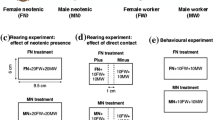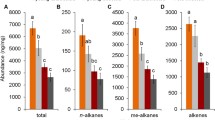Abstract
The rejection or acceptance of a foreign reproductive by an alien colony may not always be as straightforward as cue recognition between worker termites. This paper aims to determine whether adoption of foreign reproductives is caused simply by lack of intraspecific aggression or is contingent on the reproductive status of the host colony. In the fungus-culturing termites, Macrotermes gilvus (Hagen) and Macrotermes carbonarius (Hagen), major workers showed low intraspecific aggression towards non-nestmates irrespective of geographic distance between source colonies. Our results indicated that workers were hardly aggressive towards non-nestmates. In royal cell-swapping experiments, both species responded in a similar way: (1) in host colonies with nymphs present, the foreign reproductives were rejected; while (2) in host colonies without nymphs the foreign reproductives were either accepted and breeding resumed or the host colonies died eventually. Workers from the host colonies preferentially maintained offspring nymphs from which adultoid replacement reproductives develop rather than accepting foreign reproductives. There is no fitness gain for the queenless workers in accepting foreign reproductives; however, there is overall benefit to the newly born population.

Similar content being viewed by others
References
Adams E.S., Atkinson L. and Bulmer M.S. 2007. Relatedness, recognition errors, and colony fusion in the termite Nasutitermes corniger. Behav. Ecol. Sociobiol. 61: 1195-1201
Arab A., Issa S., Alfonzo D. and Jaffe K. 2006. Caste, colony, and species specificity of the trail pheromone in two sympatric Nasutitermitinae (Isoptera: Termitidae). Sociobiology 47: 345-351
Brown W.D., Liautard C. and Keller L. 2003. Sex-ratio dependent execution of queens in polygynous colonies of the ant Formica exsecta. Oecologia 134: 12-17
Bulmer M.S. and Traniello J.F.A. 2002. Lack of aggression and spatial association of colony members in Reticulitermes flavipes. J. Insect Behav. 15: 121-126
Clément J.L. 1986. Open and closed societies in Reticulitermes termites (Isoptera, Rhinotermitidae): Geographic and seasonal variations. Sociobiology 11: 311-323
Fortelius W., Rosengren R., Cherix D. and Chautems D. 1993. Queen recruitment in a highly polygynous supercolony of Formica lugubris (Hymenoptera, Formicidae). Oikos 67: 193-200
Grace J.K. 1996. Absence of overt agonistic behavior in a northern population of Reticulitermes flavipes (Isoptera: Rhinotermitidae). Sociobiology 28: 103-110
Guaraldo A.C. and Costa-Leonardo A.M. 2009. Preliminary fusion testing between whole young colonies of Coptotermes gestroi (Isoptera: Rhinotermitidae). Sociobiology 53: 767-774
Hacker M., Kaib M., Bagine R.K.N., Epplen J.T. and Brandl R. 2005. Unrelated queens coexist in colonies of the termite Macrotermes michaelseni. Mol. Ecol. 14: 1527-1532
Harahap I.S., Benson E.P., Zungoli P.A., Adler P.H. and Hill H.S. Jr. 2005. Inter- and intra-colony agonistic behavior of native subterranean termites, Reticulitermes flavipes and Reticulitermes virginicus (Isoptera: Rhinotermitidae). Sociobiology 46: 305-316
Haverty M.I. and Thorne B.L. 1989. Agonistic behavior correlated with hydrocarbon phenotypes in dampwood termites, Zootermopsis (Isoptera: Termopsidae). J. Insect Behav. 2: 523-543
Holzer B., Meunier J., Keller L. and Chapuisat M. 2008. Stay or drift? Queen acceptance in the ant Formica paralugubris. Insect. Soc. 55: 392-396
Huang Q.Y., Chen Y., Li J.H. and Lei C.L. 2007. Intercolony agonism in the subterranean termite Odontotermes formosanus (Isoptera: Termitidae). Sociobiology 50: 867-880
Inoue T., Kirtibutr N. and Abe T. 2001. Underground passage system of Macrotermes carbonarius (Isoptera, Termitidae) in a dry evergreen forest of northeast Thailand. Insect. Soc. 48: 372-377
Jmhasly P. and Leuthold R.H. 1999. Intraspecific colony recognition in the termites Macrotermes subhyalinus and Macrotermes bellicosus (Isoptera, Termitidae). Insect. Soc. 46: 164-170
Kaib M., Husseneder C., Epplen J.T. and Brandl R. 1996. Kin-biased foraging in a termite. Proc. R. Soc. B. 263: 1527-1532
Kaib M., Jmhasly P., Wilfert L., Durka W., Franke S., Francke W., Leuthold R.H. and Brandl R. 2004. Cuticular hydrocarbons and aggression in the termite Macrotermes subhyalinus. J. Chem. Ecol. 30: 365-385
Keller L. 1997. Indiscriminate altruism: Unduly nice parents and siblings. Trends Ecol. Evol. 12: 99-103
Keller L. and Nonacs P. 1993. The role of queen pheromones in social insects: Queen control or queen signal? Anim. Behav. 45: 787-794
Keller L. and Vargo E.L. 1993. Reproductive structure and reproductive roles in colonies of eusocial insects. In: Queen Number and Sociality in Insects (Keller L., Ed), Oxford University Press, Oxford, pp 16-44
Lopez-Vaamonde C., Koning J.W., Brown R.M., Jordan W.C. and Bourke A.F.G. 2004. Social parasitism by male-producing reproductive workers in a eusocial insect. Nature 430: 557-560
Matsuura K. and Nishida T. 2001. Colony fusion in a termite: What makes the society “open”? Insect. Soc. 48: 378-383
Neoh K.B. and Lee C.Y. 2009a. Developmental stages and castes of two sympatric subterranean termites Macrotermes gilvus and Macrotermes carbonarius (Blattodea: Termitidae). Ann. Entomol. Soc. Am. 102: 1091-1098
Neoh K.B. and Lee C.Y. 2009b. Flight activity of two sympatric termite species, Macrotermes gilvus and Macrotermes carbonarius (Termitidae: Macrotermitinae) Environ. Entomol. 38: 1697-1706
Neoh K.B., Lenz M. and Lee C.Y. 2010. Impact of orphaning on field colonies of Southeast Asian Macrotermes gilvus (Hagen) and M. carbonarius (Hagen) (Termitidae, Macrotermitinae). Insect. Soc. 57: 431-439
Pearce M.J., Cowie R.H., Pack A.S. and Reavey D. 1990. Intraspecific aggression, colony identity and foraging distances in Sudanese Microtermes spp. (Isoptera: Termitidae: Macrotermitinae). Ecol. Entomol. 15: 71-77
Reeve H.K. 1989. The evolution of conspecific acceptance thresholds. Am. Nat. 133: 407-435
Schuurman G. and Dangerfield J.M. 1995. Assessment of intraspecific aggression in Macrotermes michaelseni (Isoptera: Macrotermitinae). Sociobiology 26: 33-38
Shelton T.G. and Grace J.K. 1997. Suggestion of an environmental influence on intercolony agonism of Formosan subterranean termites (Isoptera: Rhinotermitidae). Environ. Entomol. 26: 632-637
Su N.Y. and Haverty M.I. 1991. Agonistic behavior among colonies of the Formosan subterranean termite, Coptotermes formosanus Shiraki (Isoptera: Rhinotermitidae), from Florida and Hawaii: Lack of correlation with cuticular hydrocarbon composition. J. Insect Behav. 4: 115-128
Sundström L. 1997. Queen acceptance and nestmate recognition in monogyne and polygyne colonies of the ant Formica truncorum. Anim. Behav. 53: 499-510
Thorne B.L. 1982a. Polygyny in termites: Multiple primary queens in colonies of Nasutitermes corniger (Motschulsky) (Isoptera: Termitidae). Insect. Soc. 29: 102-117
Thorne B.L. 1982b. Termite-termite interactions: Workers as an agonistic caste. Psyche 89: 133-150
Vander Meer R.K. and Alonso L.E. 2002. Queen primer pheromone affects conspecific fire ant (Solenopsis invicta) aggression. Behav. Ecol. Sociobiol. 51: 122-130
Vargo E.L. and Fletcher D.J.C. 1986. Evidence of pheromonal queen control over the production of sexuals in the fire ant, Solenopsis invicta. J. Comp. Physiol. A 159: 741-749
Vargo E.L. and Passera L. 1991. Pheromonal and behavioral queen control over the production of gynes in the Argentine ant Iridomyrmex humilis (Mayr). Behav. Ecol. Sociobiol. 28: 161-169
Wong N.S.C. 2006. Distribution of termite mounds in Minden Campus, Universiti Sains Malaysia (in Malay). B. Appl. Sci. Dissertation. Universiti Sains Malaysia, Penang. 59 pp
Acknowledgments
We thank Yu-Chong Lim (USM) for his technical assistance. This study was partially supported by DuPont Professional Products (USA). K.-B.N. was supported under a post-doctoral fellowship from the Universiti Sains Malaysia.
Author information
Authors and Affiliations
Corresponding author
Rights and permissions
About this article
Cite this article
Neoh, KB., Indiran, Y., Lenz, M. et al. Does lack of intraspecific aggression or absence of nymphs determine acceptance of foreign reproductives in Macrotermes?. Insect. Soc. 59, 223–230 (2012). https://doi.org/10.1007/s00040-011-0207-5
Received:
Revised:
Accepted:
Published:
Issue Date:
DOI: https://doi.org/10.1007/s00040-011-0207-5




